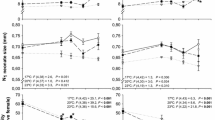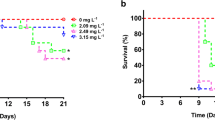Abstract
Laboratory populations of cloned Daphnia magna were exposed at different population phases (growing phase, density peak, stable phase) to the insecticide carbaryl at 15 μg 1−1, which was harmful to juveniles but not to adults, and their population dynamics were analyzed. The population declined most at the density peak, when not only juveniles but also many adult individuals died. To analyze the factors affecting population vulnerability to carbaryl, acute toxicity tests were conducted using Daphnia individuals of different body sizes under different food conditions. The test revealed that daphnid sensitivity to carbaryl increased greatly when food density was changed from a high food level to a low level. This food condition, of low availability, might be the condition to which the Daphnia populations were exposed at their density peak. The synergism of the negative impacts of anthropogenic and natural stresses such as insecticides and food shortage may control aquatic populations.
Similar content being viewed by others
References
Baudo R (1987) Ecotoxicological testing with Daphnia. In: Petera RH, de Bernardi R (eds) Daphnia. Mam Ist Ital Idrobiol 45:461–482
Dodson SI, Hanazato T (1995) Commentary on effects of anthropogenic and natural organic chemicals on development, swimming behavior, and reproduction of Daphnia, a key member of aquatic ecosystems. Environ Health Perspect 103(suppl 4):7–11
Folt CL, Chen CY, Moore MV, Burnaford J (1999) Synergism and antagonism among multiple stressors. Limnol Oceanogr 44:847–877
Hanazato T (1996) Combined effects of food shortage and oxygen deficiency on life history characteristics and filter screens of Daphnia. J Plankton Res 18:757–765
Hanazato T (1998) Response of a zooplankton community to insecticide application in experimental ponds: a review and the implications of the effects of chemicals on the structure and functioning of freshwater communities. Environ Pollut 101:361–373
Hanazato T (2001) Pesticide effects on freshwater zooplankton: an ecological perspective. Environ Pollut 112:1–10
Hanazato T, Dodson SI (1995) Synergistic effects of low oxygen concentration, predator kairomon, and a pesticide on the cladoceran Daphnia pulex. Limnol Oceanogr 40:700–709
Hanazato T, Hirokawa H (2001) Sensitivity of Daphnia pulex of different ages to the insecticide carbaryl. Jpn J Environ Toxicol 4:67–72
Hanazato T, Hirokawa H (2004) Change in vulnerability of Daphnia to an insecticide application depending on the population phase. Freshw Biol 49:402–409
Hanazato T, Yasuno M (1990) Influence of time of application of an insecticide on recovery patterns of a zooplankton community in experimental ponds. Arch Environ Contam Toxicol 19:77–83
Havens KE (1995) Insecticide (carbaryl, 1-napthyl-n-methylcarbamate) effects on a freshwater plankton community: zooplankton size, biomass, and algal abundance. Water Air Soil Pollut 84:1–10
Lampert W (1977) Studies on the carbon balance of Daphnia pulex as related to environmental conditions. 2. The dependence of carbon assimilation on animal size, temperature, food concentration and diet species. Arch Hydrobiol Suppl 48:310–335
Lampert W (1994) Phenotypic plasticity of filter screens in Daphnia: adaptation to a low-food environment. Limnol Oceanogr 39:997–1006
Organisation for Economic Cooperation and Development (OECD) (1984) Daphnia sp. acute immobilisation and reproduction tests no. 202. In: OECD guidelines for testing of chemicals. Section 2: Effects on biotic systems. OECD, Paris, pp 19–34
Author information
Authors and Affiliations
Corresponding author
Rights and permissions
About this article
Cite this article
Takahashi, H., Hanazato, T. Synergistic effects of food shortage and an insecticide on a Daphnia population: rapid decline of food density at the peak of population density reduces tolerance to the chemical and induces a large population crash. Limnology 8, 45–51 (2007). https://doi.org/10.1007/s10201-006-0193-x
Received:
Accepted:
Published:
Issue Date:
DOI: https://doi.org/10.1007/s10201-006-0193-x




